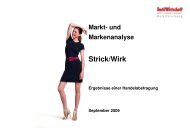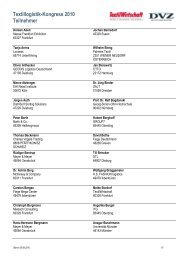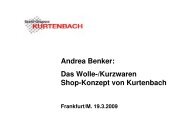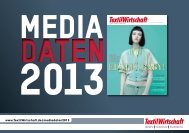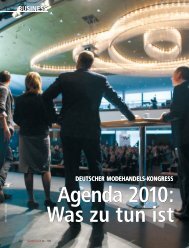UNIQLO Operations - TextilWirtschaft
UNIQLO Operations - TextilWirtschaft
UNIQLO Operations - TextilWirtschaft
You also want an ePaper? Increase the reach of your titles
YUMPU automatically turns print PDFs into web optimized ePapers that Google loves.
All the significant intercompany accounts and transactions<br />
have been eliminated in consolidation.<br />
All the assets and liabilities of newly consolidated subsidiaries<br />
are evaluated at fair value.<br />
(b) Cash and Equivalents<br />
For the purpose of consolidated statements of cash flows,<br />
the Company considers all highly liquid investments with<br />
insignificant risk of changes in value, with maturities of<br />
generally three months or less when purchased, to be cash<br />
equivalents.<br />
(c) Short-term Investments and Investments in Securities<br />
In accordance with “Accounting Standards for Financial<br />
Instruments” of the Business Accounting Deliberation Council<br />
(“the BADC”), securities other than investments in an affiliated<br />
company are classified into one of the following three categories,<br />
and the Company accounts for the securities as follows:<br />
• Trading securities, which are debt and equity securities that<br />
the Company holds for the purpose of earning profits on<br />
short-term movement of the fair market values, are reported<br />
at fair market value, with unrealized holding gains and<br />
losses included in earnings.<br />
• Held-to-maturity securities, which are debt securities that<br />
the Company has the positive intent and ability to hold to<br />
maturity, are reported at amortized cost.<br />
• Available-for-sale securities, which are debt and equity<br />
securities with fair market values that are classified as neither<br />
trading securities nor held-to-maturity securities, are<br />
reported at fair market value. Unrealized holding gains and<br />
losses on available-for-sale securities are excluded from<br />
earnings and are reported as a net unrecognized holding<br />
gain or loss, net of the related tax effect, in a separate component<br />
of net assets until realized. In computing the realized<br />
gain or loss, costs of available-for-sale securities are<br />
principally determined by the average method.<br />
Held-to-maturity securities and available-for-sale securities<br />
with no fair market value are carried at cost.<br />
Investments in unconsolidated subsidiaries and the other<br />
affiliates that are not accounted for under the equity method<br />
are reported at cost determined by the average method.<br />
(d) Allowance for Doubtful Accounts<br />
An allowance for doubtful accounts, including trade notes<br />
and accounts receivable and certain investments and other<br />
assets, is provided against probable future losses on collection.<br />
The Company and subsidiaries designate certain<br />
accounts as highly doubtful accounts and provide a specific<br />
allowance for these accounts based on the management’s<br />
detailed credit analysis. Other than these accounts, the<br />
Company provides an allowance for doubtful accounts based<br />
on the Company’s historical average charge-off ratio.<br />
58<br />
FAST RETAILING ANNUAL REPORT 2007<br />
(e) Inventories<br />
Most inventories are stated at cost. The cost is mainly determined<br />
by the specific identification method.<br />
(f) Property and Equipment<br />
Property and equipment is stated at cost. Depreciation is<br />
computed by the declining-balance method for the Company<br />
and its certain domestic subsidiaries except for the buildings<br />
acquired by certain domestic subsidiaries after April 1, 1998<br />
for which the straight-line method is used. Depreciation is<br />
computed principally by the straight-line method for overseas<br />
subsidiaries. The ranges of principal estimated useful lives are<br />
as follows:<br />
Buildings and structures 8 to 50 years<br />
Furniture, equipment and vehicles 5 to 8 years<br />
(g) Intangible Assets<br />
Goodwill is amortized on a straight-line basis over their<br />
respective estimated useful lives, not exceeding 20 years,<br />
unless it is deemed insignificant.<br />
Software for internal use is amortized on a straight-line<br />
method over 3 to 5 years of the estimated available period.<br />
(h) Retirement and Severance Benefits<br />
The Company and certain subsidiaries in Japan have defined<br />
contribution plans.<br />
Certain other domestic subsidiaries have defined benefit<br />
plans for the employees’ retirement and severance. Accrued<br />
retirement and severance obligations under the defined benefit<br />
plans are provided based on estimated projected benefit<br />
obligation and plan assets at the end of the fiscal year.<br />
Actuarial gains and losses are recognized as income or<br />
expense on a straight-line basis over certain years, beginning<br />
with the next fiscal year of occurrence, principally over seven<br />
years, not exceeding the expected average remaining working<br />
lives of the employees participating in the plans.<br />
(i) Leases<br />
“Accounting Standards for Leases” of the BADC permits<br />
lessees to account for as operating leases as to finance leases<br />
without transfer of ownership of leased assets from the<br />
lessor to the lessee, while it requires that finance leases<br />
resulting in the transfer of the ownership by the end of the<br />
lease term shall be accounted for as capital leases by recognizing<br />
assets and the corresponding obligation on the<br />
lessee’s balance sheet. All finance leases of the Company<br />
and subsidiaries in Japan are accounted for as operating<br />
leases, and the lease payment is expensed over the lease<br />
term as it becomes payable. Leases of overseas subsidiaries<br />
are accounted for as capital leases.<br />
(j) Revenue Recognition<br />
The Company and subsidiaries recognize sales revenue upon<br />
the sale of merchandise to customers where the title of the<br />
merchandise transfers to the customers.




